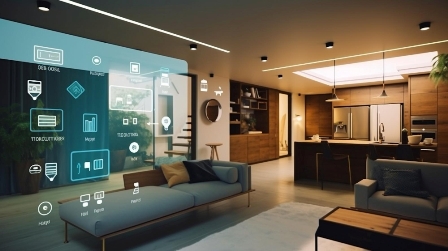In an era where technology is seamlessly integrated into various aspects of our lives, the concept of a tech-infused home has become more than just a trend—it’s a way of life. The pursuit of convenience in our daily routines has fueled the rise of smart homes, where appliances and devices are interconnected to simplify tasks and enhance overall living experiences.
Smart Home Basics
Let’s start by understanding what constitutes a smart home. In simple terms, a smart home is equipped with devices and appliances that can be controlled remotely and are often automated for increased efficiency. These devices, collectively known as the Internet of Things (IoT), contribute to creating an environment where the mundane becomes automated, and the home adapts to the needs of its inhabitants.
The Rise of Tech-Infused Homes
The statistics speak for themselves—the adoption of smart home technology is on the rise. More households are embracing the convenience and efficiency that tech-infused living offers. Factors such as increased connectivity, improved device affordability, and a growing awareness of the benefits are contributing to the widespread acceptance of smart homes.
Smart Appliances in the Kitchen
One of the focal points of a tech-infused home is the kitchen. Imagine having a refrigerator that notifies you when groceries are running low or a stove that can be controlled with a smartphone app. Smart kitchen appliances are revolutionizing the way we cook and manage our food. From smart ovens to coffee makers, these devices make culinary tasks more manageable and enjoyable.
Connected Living Rooms
Moving beyond the kitchen, the integration of technology extends into the living room. Smart entertainment systems, including voice-controlled devices like virtual assistants, have become staples in modern households. The ability to control lighting, music, and even home security through voice commands adds a new level of convenience to daily life.
Smart Security Systems
As our homes become more connected, the need for robust security systems has never been greater. Smart security devices, such as smart cameras and doorbell cameras, offer real-time monitoring and enhanced protection. The peace of mind that comes with knowing you can check on your home from anywhere in the world is invaluable.
Automated Lighting Solutions
Smart lighting goes beyond the convenience of turning lights on and off remotely. These systems offer energy efficiency by adjusting brightness based on natural light conditions and personal preferences. With customizable lighting scenes and color options, smart lighting transforms the ambiance of any room with a simple tap on a smartphone.
Intelligent Climate Control
Maintaining a comfortable home environment is made effortless with smart climate control systems. Smart thermostats learn from user behaviors and adjust heating and cooling settings for optimal comfort and energy savings. These devices not only enhance convenience but also contribute to a more sustainable and eco-friendly lifestyle.
Efficient Cleaning with Smart Tools
Say goodbye to traditional vacuuming and cleaning routines. Smart cleaning tools, such as robotic vacuum cleaners, take the chore out of household cleaning. These devices navigate through spaces, avoiding obstacles, and ensuring every nook and cranny is attended to without manual intervention.
The Future of Home Convenience
What lies ahead for the future of convenience in our homes? The possibilities seem limitless. Emerging technologies, such as augmented reality and artificial intelligence, are expected to further enhance the capabilities of smart homes. We can anticipate homes that adapt to our preferences seamlessly, making everyday tasks even more effortless.
Challenges and Concerns
However, as we embrace the convenience of tech-infused living, it’s essential to address potential challenges. Privacy and security concerns are paramount, requiring robust measures to protect personal data. Additionally, maintenance and compatibility issues may arise as technology evolves, necessitating continuous updates and user education.
Balancing Convenience and Sustainability
While convenience is a key driver of smart home adoption, it’s crucial to consider the environmental impact of increased electronic consumption. Striking a balance between convenience and sustainability involves making conscious choices in the types of devices we integrate into our homes and adopting eco-friendly practices.
User-Friendly Interfaces
A critical aspect of smart home technology is the user interface. Devices must be intuitive and easy to use to ensure widespread adoption. From touchscreens to voice commands, creating user-friendly interfaces is essential for making tech-infused homes accessible to people of all ages and technological backgrounds.
Affordability and Accessibility
Accessibility to smart home technology is a key factor in its widespread adoption. As the market expands, efforts to make devices more affordable and user-friendly have become evident. Trends in pricing indicate a gradual decrease, making tech-infused living accessible to a broader audience.
FAQs
Yes, most smart home devices employ robust security measures to protect user data. However, it’s crucial to follow best practices, such as regularly updating software and using strong passwords.
Many smart appliances are designed with energy efficiency in mind, contributing to reduced energy consumption and lower utility bills.
The affordability of smart home devices varies, but with increasing competition and advancements in technology, prices are generally becoming more accessible.
Yes, many smart devices are designed for easy integration into existing homes. Retrofitting allows homeowners to enjoy the benefits of a tech-infused home without major renovations.
The lifespan of smart home devices varies, but with proper maintenance and updates, many can provide years of reliable service.
Conclusion
The future of convenience lies in the heart of tech-infused homes. From smart kitchens to intelligent climate control, the integration of technology continues to transform the way we live. As we navigate the challenges and embrace the benefits, the journey toward a more connected and convenient home is an exciting evolution in modern living.






